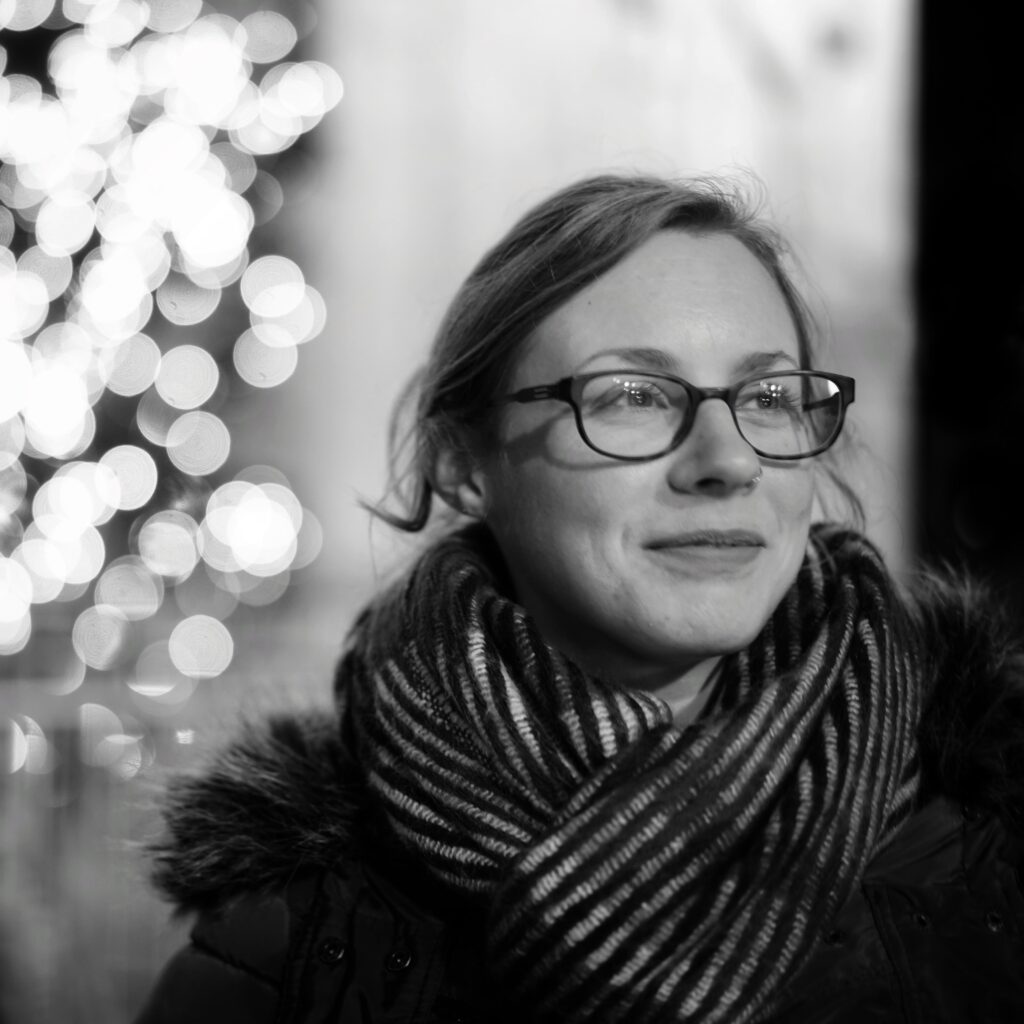
By Erin Calabria
It is a clear, mild day in October, my first time home in nearly three years. All the leaves are glowing, suspended in translucent tiers of colored light, just on the brink of letting go. My brother turns off the road, parks, then leads the way into the woods. Almost as soon as we enter, we hear their needle-bright voices: kinglets, a group of them calling back and forth as they forage beside the path, crowns sparking gold among the hemlocks.
When we were young, my brother taught me how to look and listen for birds. He taught me how they measured time with their songs, with their comings and goings, how they marked the passage and return of every season. In winter, I learned to differentiate the sparrows at the feeder outside—tree sparrows from chipping, song sparrows from white-throated or fox. In spring, we would ramble the woods just as the warblers returned north, waiting for the first adamant call of an ovenbird, the first cheerful buzz of a black-throated green. Later, on hot summer nights, we would listen for the spiraling trill of veeries at the edge of the trees, and when the dusk turned cool in autumn, we would look up towards the stars, towards the quick, piping shadows of songbirds migrating through the dark.
Lately, I’ve been thinking about how writing alters our experience of time. In his newsletter, Matt Bell writes, “no matter how fast something happens in real life, you can usually make it go slower in prose.” Bell then quotes an interview with Chris Bachelder, who says, “I think there are writers who attempt to propel and writers who attempt to arrest, and I think there are readers who prefer to be propelled and readers who prefer to be arrested. Obviously, I would prefer to arrest and be arrested, perhaps in part because in everyday life I feel so inattentive and scattered. Fiction can focus my attention, slow me down, make me more mindful and aware.”
Birds, I find, can do this too. They can stop us in our tracks, turning our attention towards a flash of bright feathers, an unfamiliar song. Birds inhabit the same world we do, and yet, through flight, through camouflage and concealment, they seem capable of transcending it. The moments when their lives intersect with ours can sometimes feel like a divine visitation, a portal opening between parallel universes or a border thinning between seen and unseen. And I couldn’t say why we humans are so enthralled with other worlds, but I think it must be connected to our experience of art. Because this is also what happens when we create or take in art, whether that means reading, listening to music, gazing at an image or sculpture, sinking into a film: we enter an elsewhere, a different plane where space and time shifts.
I often think about stories as not just temporal, but as spatial and immersive—as landscapes. Of course, setting represents only one layer of a story’s immersive effect; the forests of the oldest fairytales are as much about the internal as the external journey. Ursula K. Le Guin, another author who seemed to prefer fiction to arrest rather than propel, invoked the forest metaphor to describe how she was less interested in “action” and more interested in “what goes on inside. Inner space and all that. We all have forests in our minds. Forests unexplored, unending.”
But what do you do if, while writing, you feel afraid or unable to enter that inner forest? Or else, what happens if you become lost and isolated among the trees, doubtful that you will ever discover the path or the magic you sought there in the first place? In those moments, when the landscape of a story feels unreachable or impenetrable, I find myself drawn outward, into worlds beyond my own mind. A real forest is best if I can find one, but any river or city park will more than suffice, and a window will do in a pinch. As long as I can see—and even better, hear—the birds.
Sometimes, observing birds simply provides a distraction, a dose of wonder that breaks through mental brambles, releasing and refreshing the imagination. Other times, birds have taught me more concrete lessons. Paying repeated visits and attention to their haunts gives me tangible reminders that persistence is very often rewarded, given a little time; how else would I discover where to listen for the tap-tap of a thrush cracking open a snail on its rock anvil? How would I know which unassuming tangle of green to watch for a red-backed shrike to return for a mere five weeks each summer, weaving its nest and larder of thorns? And yet, birds also remind me that inspiration will arrive separate from any persistent striving on my part, unexpected but inevitable, like the white morph buzzard that landed once at the top of a flowering linden in our local park, or the pair of redwings that wandered down from their Palearctic wintering grounds during a sudden cold snap.
More even than that, birds restore something in me that is difficult to name. Sometimes, I consider Emily Dickinson’s familiar line: “‘Hope’ is the thing with feathers.” It’s a stunning opening to a poem; however, I’ve always found it difficult to swallow the last two lines: “Yet – never – in Extremity, / It asked a crumb – of me.” Perhaps this was an aspirational idea for Dickinson as well, the way many artists create what they feel they lack, but I’m guessing most of us would run out of fingers trying to count the things that hope has asked of us of late.
At some point while living in Germany, I found a darker poem “Die Vögel Singen Weiter” (“The Birds Will Keep on Singing”) by Anise Koltz, one of Luxembourg’s most famous poets. Koltz wrote the poem in German, which was for her a language of trauma and occupation and one she later eschewed in favor of Luxembourgish and French. Instead of buoyant, rhyming stanzas, Koltz’s sparse free verse stands—and sings—in place. Literally translated, the poem reads: “Hew off my branches / and saw me into pieces / the birds will keep on singing / in my roots.”
There’s a fierce resistance in Koltz’s words, an assertion of beauty and creativity in the face of destruction, but I would not say the poem strikes me as hopeful, not exactly. There is no averting of violence and loss; and yet, there is a resolute constancy, a rootedness that remains untouched by any ruin, unmoved by any end goal or timeline. A faithful abiding.
In many respects, writing is super-, maybe even omnitemporal. Besides the way writing can propel or arrest, there is the way a narrative might skip around, flashing back and forth in time. There is the way a finished work contains multiple hours, days, even years of the author’s repeated effort and revision, and the way we all communicate with the past every time we read and with the future every time we write. I think this is why, when I am most astray in my writing process, I seek the presence of creatures who have been here much longer than us. Creatures who, in their evolutionary history, survived an apocalypse, who fashioned feathers and wings and songs. Creatures like those kinglets, some of the smallest birds in North America, who weigh the same as two pennies in your hand and who even now are only ever a snowstorm away from perishing, who live on the brink of ruin and still sing to each other each day until dark.
When I cannot find my way in imaginary worlds, birds remind me of my place here, in this world. They remind me how to be arrested, and how to abide. And while I still don’t have a word for that gift, I will carry it with me, a magic charm, a talisman, the next time I enter the forest within.
Sources/Further Reading:
Bell, Matt. “Exercise #33: Writing Physical Action with Embodied Perception and Consecution.” No Failure, Only Practice, 3. Aug. 2022. https://mattbell.substack.com/p/exercise-33-writing-physical-action.
Koltz, Anise. “Die Vögel Singen Weiter.” Steine und Vögel. Bechtle Verlag, 1964, p.5.
Le Guin, Ursula K. Preface to “Vaster Than Empires and More Slow.” The Wind’s Twelve Quarters.Harper & Row, 1975, p. 181.
Read more of Erin’s work here at Reckon:
Soundscapes: A Story as a Place to Dwell
Soundscapes: Radio Lessons
Fiction: Lampyridae

Erin Calabria
Erin Calabria grew up on the edge of a field in rural Western Massachusetts and has since lived in Magdeburg, Germany and New York City. She studied audio storytelling at the Salt Institute for Documentary Studies and is a co-founding editor at Empty House Press, which publishes writing about home, place, and memory. In her spare time, she likes to learn tunes by ear on the piano, fiddle, and tin whistle, or else visit the birds in her neighborhood park. You can read more of her work in Little Fiction, Milk Candy Review, Longleaf Review, Pithead Chapel, and other places.
